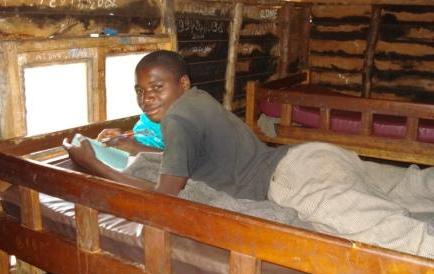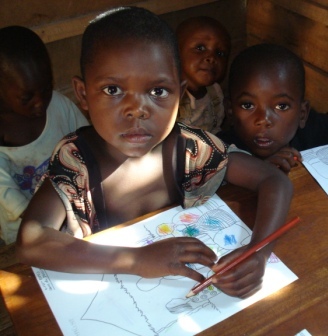Centers
CTO (Centre de Transit et d’Orientation), Transit and Orientation Center
for children demobilised from armed forces and groups - Center For Ex-Child soldiers
1. Informing and training FARDC military officers (or commanders of armed
groups) on the rights and protection of children affected by armed conflicts
UNICEF (United Nations Children’s Fund), MONUSCO (United Nations Stabilization
Mission in the Democratic Republic of the Congo) and BVES have worked together
to train and raise awareness amongst the military regarding children’s rights
and protection, with a particular focus on DDR (their Disarmament,
Demobilisation and Reintegration). These same training programs have also been
organised to educate sectors of civil society.
2. Negotiating with militia and armed groups for the liberation of children
Once awareness and training have been completed, BVES engages in long and hard
negotiations with military leaders in order to free child soldiers.
The term EAFGA – (Enfants Associés aux Forces et Groupes Armés) Children
Associated to Armed Forces and Groups – is used to describe every person aged 18
years or younger who currently is or in the past has been recruited or used in
armed forces or groups. This includes children, both boys and girls, used as
combatants, transporters, cooks, messengers, spies or exploited for sexual
purposes.
This work involves the close cooperation of BVES with the UEPNDDR (Implementing
unit of the national programme for Disarmament, Demobilisation and
Reintegration, formerly CONADER), the child protection sector of MONUSCO and
UNICEF.
3. Welcome and Support of ESFGA’s at the CTO (Transit and Orientation Center)
 ESFGA
(Enfants Sortis des Forces et Groupes Armés) – Children released from Armed
Forces and groups - is a term used to describe children who have subsequently
been freed from or left their military role, and are EAFGA’s that have been both
verified and certified. These children have been guided towards the CTO were
they are warmly welcomed (girls and boys are kept separate) and receive varied
humanitarian assistance. ESFGA
(Enfants Sortis des Forces et Groupes Armés) – Children released from Armed
Forces and groups - is a term used to describe children who have subsequently
been freed from or left their military role, and are EAFGA’s that have been both
verified and certified. These children have been guided towards the CTO were
they are warmly welcomed (girls and boys are kept separate) and receive varied
humanitarian assistance.
They benefit from a medical check and psychosocial care to help them through the
trauma suffered. This is in addition to re-educating them at whatever level
necessary, bearing in mind that some may never have gone to school. They may
also enjoy guidance regarding their future: The children might be directed
towards full or vocational education, as well as professional apprenticeships,
their respective path will be chosen based on whatever is more appropriate. They
will also be aided in their own personal development through specific projects
with the help of our social workers.
Their stay lasts for approximately 3 months. This is the minimum time necessary
in order to help the supervised transition from a militant to civilian and to
reintegrate children within families. This time is also needed by BVES and his
partners to perform family and community research and mediation in order to
reunite and reintegrate children. An official certificate of discharge from
military officer is also provided.
The main objectives of the CTO:
- To ensure the physical and psychological rehabilitation of demobilised child
soldiers
- To facilitate reintegration into family and community
- To protect the children against all forms of re-recruitment
In order to achieve this, an educational program is implemented day and night by
social workers and policy makers involving many activities, both creative and
recreational. The children participate in activities themed on HIV and AIDS,
human rights, peaceful cohabitation, good values, development, prevention of
reenlistment after being reintegrated into families and the community, etc.
4. Family and Community reunification
Generally speaking, family reunification is the preferred solution above any
other, when the conditions of the child, family and environment (in terms of
security and community) are permitting it. Amongst the different solutions of
reintegration, priority is given to reunification of the children with their
immediate or extended family as soon as possible. Where this is impossible, the
children are directed toward the FJA (Foyer pour les Jeunes Autonomes – Youths
homes) and BVES follows up on them.
In order to prepare the children before sending them back to their families,
they are given material aid (clothes, shoes, etc.). The process of family
reintegration is made official with a ceremony, and this helps to fight against
the re-recruitment of the demobilised child soldiers.
5. Monitoring and Support of community-based economical reintegration of ESFGA’s
that are reunified with their families
After the reunification of a child with his or her family, BVES begins to
monitor and make monthly visits to evaluate the state of affairs, the evolution
of its project, and to facilitate an alternative reorientation for the child if
necessary.
Demobilised child soldiers may choose to return to school or to learn an
income-earning profession at the heart of their respective communities. BVES
provides financial and material aid to each of these child reinsertion projects.
6. Prevention of recruitment or re-recruitment
In addition to the educational rehabilitation of at-risk children (displaced,
homeless, or those without any parent or guardian), BVES also creates and
coordinates nucleic communities for the protection of child rights. Frequent
correspondences regarding the protection of children are organised by BVES field
officers and Children protection community officers with FARDC officers and
officers of other armed groups.
CT-ENA (Centre de Transit pour les Enfants Non Accompagnés), Transit Center for
children without guardian - Center for the protection of small children and
girls separated from their families because of war
 During
the negotiation with armed forces and groups for the freedom of child soldiers,
other categories of children are also taken in by BVES, such as the ENA’s
(Children without guardian). Sometimes these are the children of armed forces,
captured by the FARDC during the course of combat and found in prison. During
the negotiation with armed forces and groups for the freedom of child soldiers,
other categories of children are also taken in by BVES, such as the ENA’s
(Children without guardian). Sometimes these are the children of armed forces,
captured by the FARDC during the course of combat and found in prison.
These children are placed in the CT-ENA, Transit center for children without
guardian or involuntarily separated from their families as a result of war.
There, they have access to various services and are helped in being reunited
with their families.
CRS (Centre de Rattrapage scolaire), Centers of educational rehabilitation
BVES also consists of 29 centers for educational rehabilitation, created within
communities that have fallen prey to the instability in South-Kivu. These are
education centers for the benefit of at-risk children (displaced children,
street children, orphaned children, etc.).
They provide a certificate of primary education after a period of 3 years. These structures are in place help to prevent the violation of children’s rights
(recruitment by armed forces or groups, sexual exploitation etc.), but they also
serve as a means of recuperation and reintegration of thousands of children who
have been affected by poverty and armed conflict.
These structures are in place help to prevent the violation of children’s rights
(recruitment by armed forces or groups, sexual exploitation etc.), but they also
serve as a means of recuperation and reintegration of thousands of children who
have been affected by poverty and armed conflict.
CDPDE (Centre de Documentation et de Plaidoyer pour les Droits des Enfants),
Documentation and Advocacy Center for Children’s Rights
This center aims to create a live and interactive library where activity
leaders, youths, children or others that are interested in the subject of
children’s rights may come here to research and spark critical debates on the
matter of these rights in the DRC. At present, the center is looking for book
donations. A meeting room is in the process of being fitted out and already
receives many visitors each month.
CPDJF (Centre pour la Protection des Droits de la Jeune Fille), Center for the
Protection of Young Women’s Rights
This center promotes women’s rights from a very young age. It offers important
services to young girls such as humanitarian assistance, education, medical aid
and advices. The girls who have fallen victim to forced prostitution, rape,
sexual violence and exploitation within armed forces and groups are welcomed
there to find solutions about reintegration into the community.
CPDEDR (Centre pour la Protection des Enfants de la Rue), Center for the
protection of street children
Such a phenomena is very prominent in the DRC. BVES uses this transit center to
escape from marginality, provide psychological care, in addition to familial and
community reintegration. This center also offers guidance on re-educating or
offering a professional apprenticeship to these street children.
Community Structures for the protection of children’s rights: Nucleus, Networks,
and Committees
In its community-based approach, “the community takes responsibility for the
protection of children’s rights”, BVES promote such a scheme that seeks to make
the community responsible in guaranteeing their children’s protection, in the
more poverty stricken and unstable districts of rural towns and areas.
For more information, please contact us.
|
